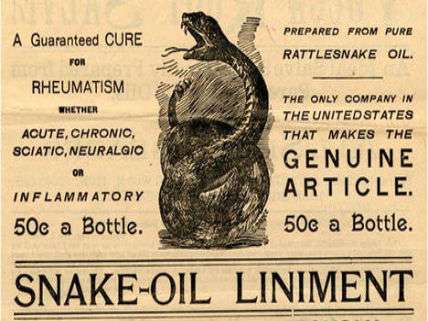Time Magazine Promotes Superstitious Chemophobia
Toxicologists liken the endocrine disruption hypothesis to homeopathy.

When environmental activists could no longer maintain with a straight face that exposure to trace amounts of synthetic chemicals is a significant cause for cancer in people, the endocrine disruption hypothesis was ginned up. The idea is that chemicals that mimic estrogen are causing epidemics of deformed penises, lower sperm counts, premature development of breasts in girls, shorter anogenital distances in men, diabetes, ADHD, and reduced cognitive function. Today, Time magazine is reporting a correlational study that claims to have sufficiently tortured the data, ah, quantified the economic harm that these estrogen-fueled epidemics is causing.
The researchers had previously calculated the losses from endocrine disrupting chemicals (EDCs) have imposed on hapless Europeans at annual cost of €163 billion (1.28 percent of EU Gross Domestic Product). "We conclude that endocrine disrupting chemical exposures in the EU are likely to contribute substantially to disease and dysfunction across the life course with costs in the hundreds of billions of Euros per year," they report. "These estimates represent only those endocrine disrupting chemicals with the highest probability of causation; a broader analysis would have produced greater estimates of burden of disease and costs."
These intrepid researchers have now turned their attention to the United States. Of course, they find, that the situation is even worse here than across the pond. From the study:
The disease costs of EDCs were much higher in the USA than in Europe ($340 billion [2·33% of GDP] vs $217 billion [1·28%]). The difference was driven mainly by intelligence quotient (IQ) points loss and intellectual disability due to polybrominated diphenyl ethers (11 million IQ points lost and 43?000 cases costing $266 billion in the USA vs 873?000 IQ points lost and 3290 cases costing $12·6 billion in the European Union).
Time does acknowledge that the results are correlational (and if you read through the earlier European study you will find that torturing the data will in fact make them confess to anything). However, Time continues, "But while research showing the connection between many chemicals and endocrine disruption remains correlational, many scientists say the burden should still rest on manufacturers to prove a substance is safe before selling it to the public." Pure precautionary principle nonsense.
In any case, a group of real toxicologists in their scathing article, "Endocrine Disruption: Fact or Urban Legend?," have likened endocrine disruption research to homeopathy. Why? Because many endocrine disruption researchers claim that lower doses of EDCs cause more harm than higher doses. No really. The toxicologists make fun of this "interesting hypothesis" by suggesting if it were true then that would mean eating Chinese meal containing low-doses of estrogenic compounds found in soybeans would be far more dangerous than taking a daily birth control pill.
As I report in The End of Doom, the toxicologists note that during the past twenty years hundreds of millions of euros and dollars of taxpayer money have been spent on endocrine disruptor research with essentially no results. They bluntly suggest that all this funding has likely produced "a vested interest of scientists in the endocrine disruption field to keep the endocrine disruption hypothesis on the agenda in order to stay in business." Decades of research and hundreds of millions of dollars in funding have resulted in the publication of more than 4,000 diff erent articles. "Taking into account the large resources spent on this topic, one should expect that, in the meantime, some endocrine disruptors that cause actual human injury or disease should have been identified," the researchers argue. "However, this is not the case. To date, with the exception of natural or synthetic hormones, not a single, man- made chemical endocrine disruptor has been identified that poses an identifiable, measurable risk to human health." They damningly add, "Certainly, there has been much media hype about imaginary health risks from bisphenol A, parabens, or phthalates. However, no actual evidence of adverse human health effects from these substances has ever been established. To the contrary, there is increasing evidence that their health risks are absent or negligible—or imaginary."
They summarize the ideology driving the endocrine disruptor scare: "Perhaps the entire issue of purported health risks of chemical EDs is just another version of the trivial dichotomy natural is good versus man-made is bad." Well, yes.


Show Comments (27)